In Mandandanji country
I’m very sorry for the scattiness of yesterday’s post – I was so tired and my proof-reader was asleep! The way I work is to make rough notes as we go, paste them into the blog, and then massage them into shape. Unfortunately, the massager’s hands were not up to scratch last night. I have now edited the post, so if something didn’t make sense when you read it, it will hopefully make sense now!
The reason I was tired is because of Day 17’s adventures. We have been blogging one day behind ever since early in the trip when we had no reception one night. (I tried to catch up with a two-day post in Mt Isa but with my COVID in full throttle, I ran out of puff and had to back out of that plan.) Day 17 was a big one as you will see, but the significant news of that day is that I tested negative, so I could partake of the adventures! First, though, the itinerary:
“We continue south into the Carnarvon National Park. An oasis in the heart of Queensland, Carnarvon National Park is characterised by towering white sandstone cliffs and pockets of rainforest. It is also known for its incredible abundance of wildlife, being home to over 180 species of birds, 90 reptiles, 22 frog species and five of our six species of gliders. It is also a refuge for Australia’s two monotremes, the Platypus and Echidna.
Today, there are numerous guided walks available depending on your level of fitness. Spot an elusive Platypus on a gentle nature trail or, for the more seasonal [“seasoned” I think they mean] walkers, head up the gorge to Moss Garden where the water seeping out of the limestone supports a lush carpet of mosses and ferns. Your experienced guides will explain”
So, it was a big day. It started with a 6:30am breakfast and departure at 7.15am, followed by 45 mins drive to Rolleston for a quick leg-stretch and toilet-break, then 1 hr 30mins drive to the Gorge. We arrived a little before 10am. We were to spend 4 hours at the Gorge, after which there was 3 hours driving, plus the requisite break, to Roma. We arrived at Roma around 5:30pm. A big day.
I mentioned before the minimal references to First Nations people. Well, today we had a little more, starting with the turn off to Old Rainworth Fort, just south of Springsure, being pointed out. The fort was “built in 1862 as protection against aboriginal attack. The fort was fireproof and very nearly impregnable, being constructed of basalt blocks and corrugated iron”. It was, however, never used apparently! (This what happens on tours – you see many signs to points of interest that you don’t get to see – but then again, this happens on self-drive holidays too, doesn’t it? You can’t see everything.)
The next references happened during our quick leg-rest-cum-toilet stop at a lovely little park in Rolleston, which is on Ganulu (or Kanolu) country. Here there was clear recognition of the local people, including a scar tree and a gorgeous map.
After this, it was more driving, but the scenery was interesting. It’s pastoral – mostly beef – country, but the breeds were changing from the strong Brahman influence of the north to Angus, Hereford, and Murray Grey. Gradually, the Carnarvon Ranges appeared on the right, and the Expedition Ranges on the distant left. As we drove, our tour leaders told us that the Carnarvon Ranges, at 1100 metres, are often described as the “Rooftop of Queensland”. (For our readers from overseas, Australia is an old worn down continent so our heights are not high!)
At Carnarvon Gorge
At the Gorge we met our Savannah Guides/Australian Nature Guides, Simon and Michelle, and had our morning tea. Eight of the 30 of us opted for the Moss Garden Walk. We were read the riot act about what this involved – 7.2km, 600 steps, three creek crossings, and 5 ridges. I was anxious about the creek crossings, because my balance isn’t great. I do not want to fall and break a bone. Len was more anxious about the steps. But we did it – and more comfortably than we expected. (Meanwhile, the Outback Spirit tour leader who accompanied us, was more concerned about the octogenarians. “You won’t fall will you, because I can’t carry you”, she said!) As it turned out, no-one fell and all made it back on time.
Michelle was our tour guide (with the Outback Spirit leader), while Simon at the other Outback Spirit leader stayed back and did small walks. Michelle was wonderful. As we walked, she’d stop and explain the environment, what we were seeing, and what was interesting, unique or special. Plants have worked things out, she said, without our help! I’m not sure scientific Len would explain it quite that way, but we know what she meant. She also talked a little about the local First Nations people. She told us about (but I’m not going to give you the details!):
- Cycads, which we’ve met before in the Northern Territory and on this trip further north, but they are old and fascinating plants
- Woody pear tree (Xylomelum pyriforme in the Proteaceae family)
- Xanthorrhoea, which were flowering
- Climbing tree orchid, but I’m not sure of its botanical name
- Quinine bush (Petalostigma pubescens), which is native to Papua New Guinea, Queensland, Northern Territory, New South Wales, Western Australia. This bush, Michelle said, was used by the local First Nations people for birth control. This people believed that three children per couple was the workable number for their community and resources, so when a woman had had three children (who had passed the infant mortality stage), they would take a preparation from this bush which would render her permanently infertile. Women would apparently also use a lower dose to bring about an abortion, if, for example, a pregnancy was too close to the previous one, as they also had ideas about spacing children. This, she said, was “women’s business”, but men had their own interesting “snip” at puberty (which they would reverse when it was time to have children.) All this revealed a sophisticated understanding of reproduction, for a start, that they were not given credit for by the settlers.
Michelle said that First Nations people used this place, this gorge, but they didn’t live here permanently. She believes this was because they recognised what was needed to conserve it. They lived in less well resourced areas, and only visited here.
Anyhow, eventually, we met the tricky creek crossing, and Michelle did two things to make it easier. One was to tell us to avoid the tempting, big (and higher) stones, because they require more strength and control to step down from. The other was that she demonstrated her preferred path across the creek. These two pieces of advice took the stress out, and I found it much easier, and less nerve-wracking than I expected.
Finally, we reached the Moss Garden, where we ate our packed lunch. (While others had sandwiches, my gf lunch was a salad bowl with dressing and no cutlery. Oh well, fingers were made before … I managed to eat my lunch perfectly well!) Moss Garden was like a little oasis. Here, a small waterfall cascades over the sandstone ledge, with a clear pool below. There are gorgeous rocks, water-carved boulders, and a variety of ferns, mosses, and liverworts. It was a worthy destination for our effort!
On the way back, Len and I brought up the rear with Michelle, and she treated us to the sight of Striated Pardelotes flying out of burrows at the side of the path. We’d not seen that before. And that generated a little discussion about snakes, goannas and pardelote burrows. She also pointed out a goanna (lace monitor) track on the path we were walking.
Then it was on to Roma
From here we had a 3-hour drive to Roma. We passed through Injune (which apparently resulted from someone misspelling the creek name Injohn as Injune!) It has a population of 400. We drove past native cypress pine stands for which a sawmill still operates in Injune. We drove back over the Great Dividing Range to be on the west side and back into the Murray-Darling catchment.
We arrived at Roma soon after 5pm, and for the first time in over a week, Len and I were able to dine at the communal tables. How lovely that was to be part of the group, again. We dined with the UK couple, a couple from Tamworth, and a single woman from Adelaide – all friendly, interesting people.

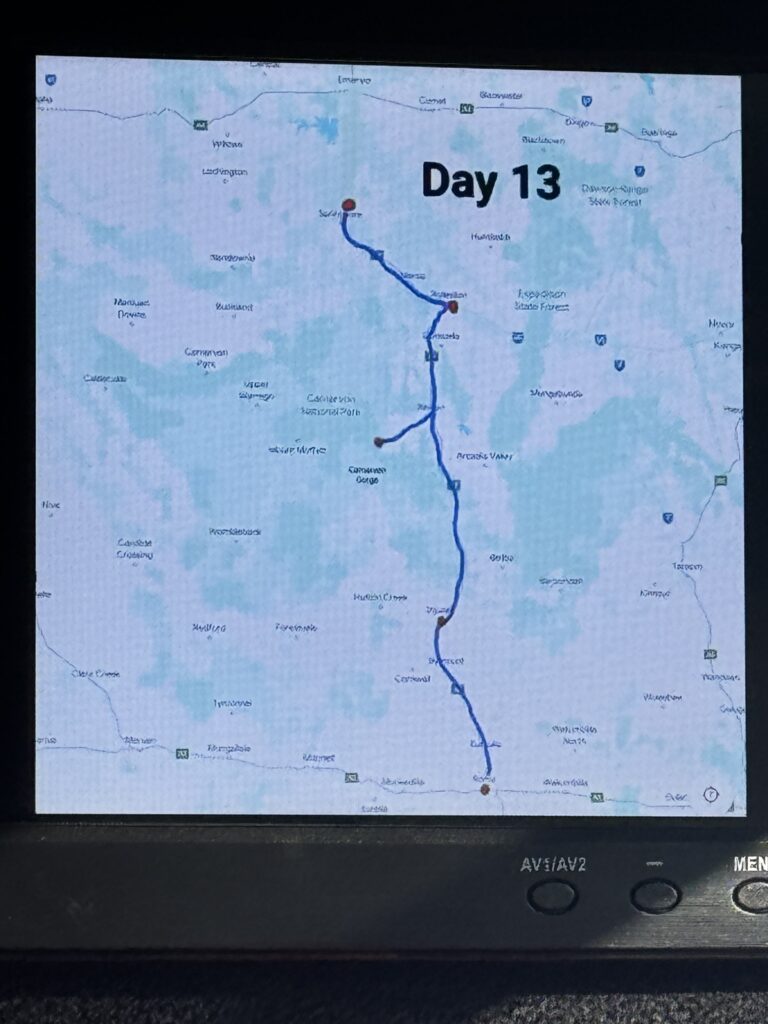

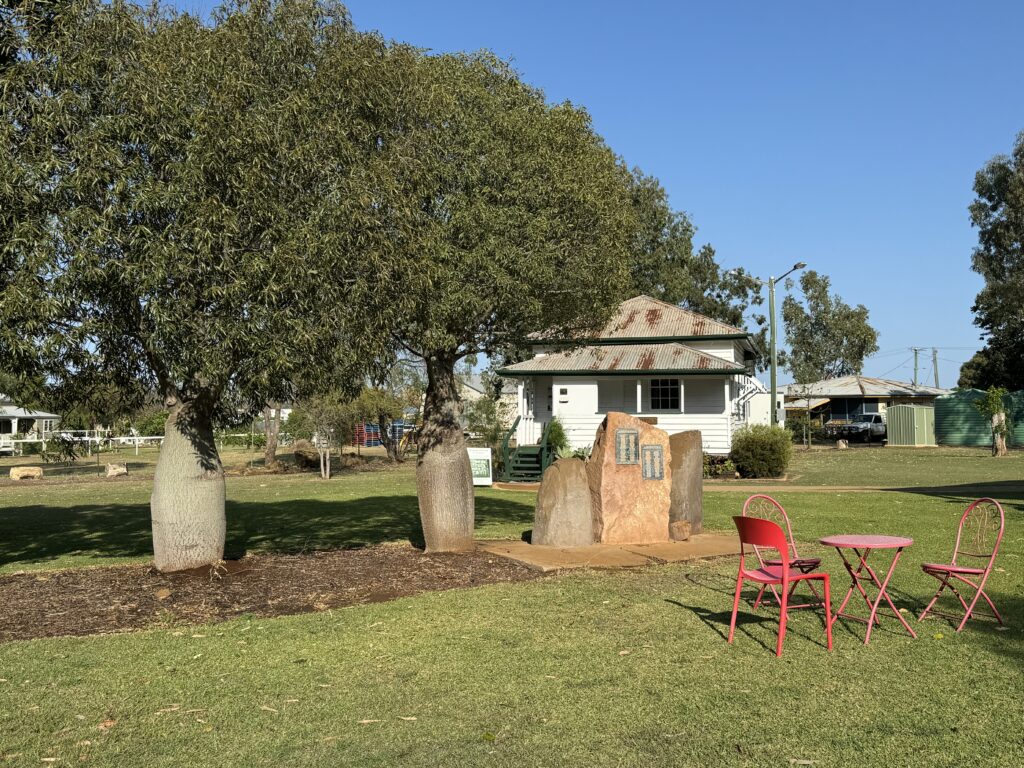


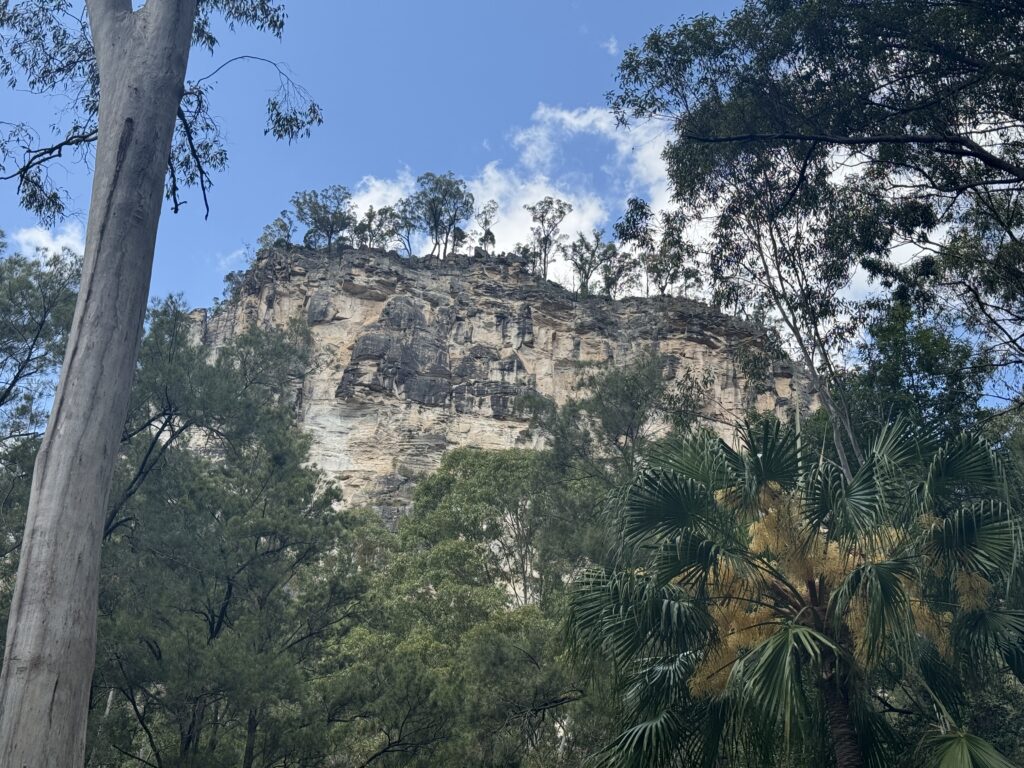

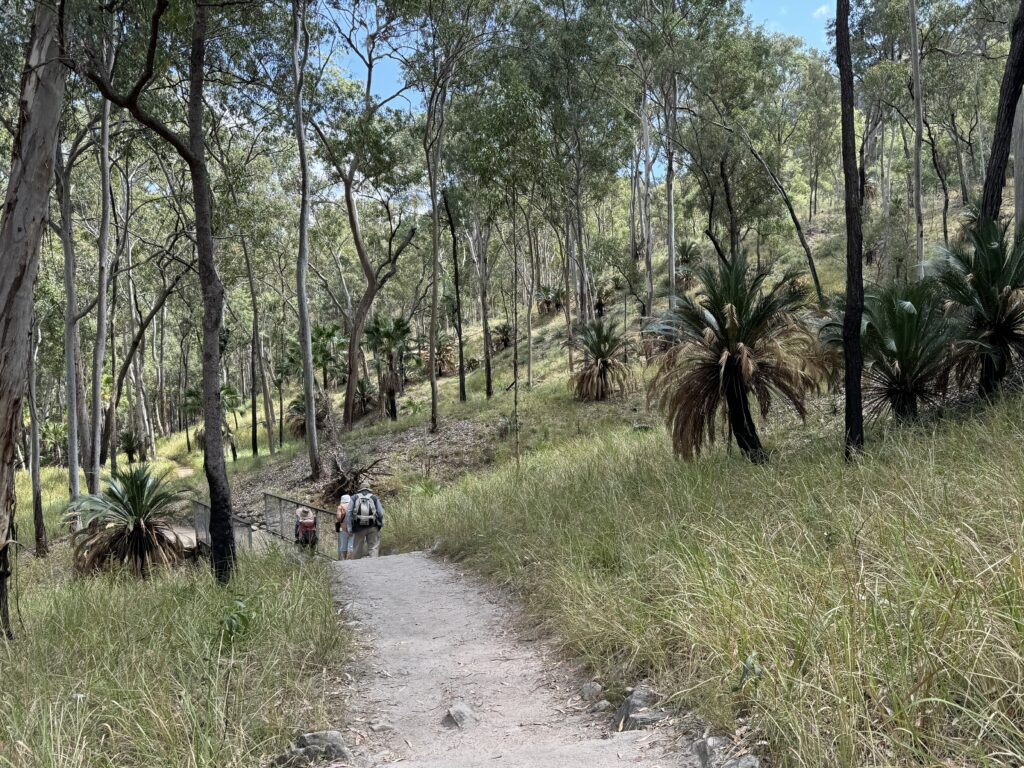




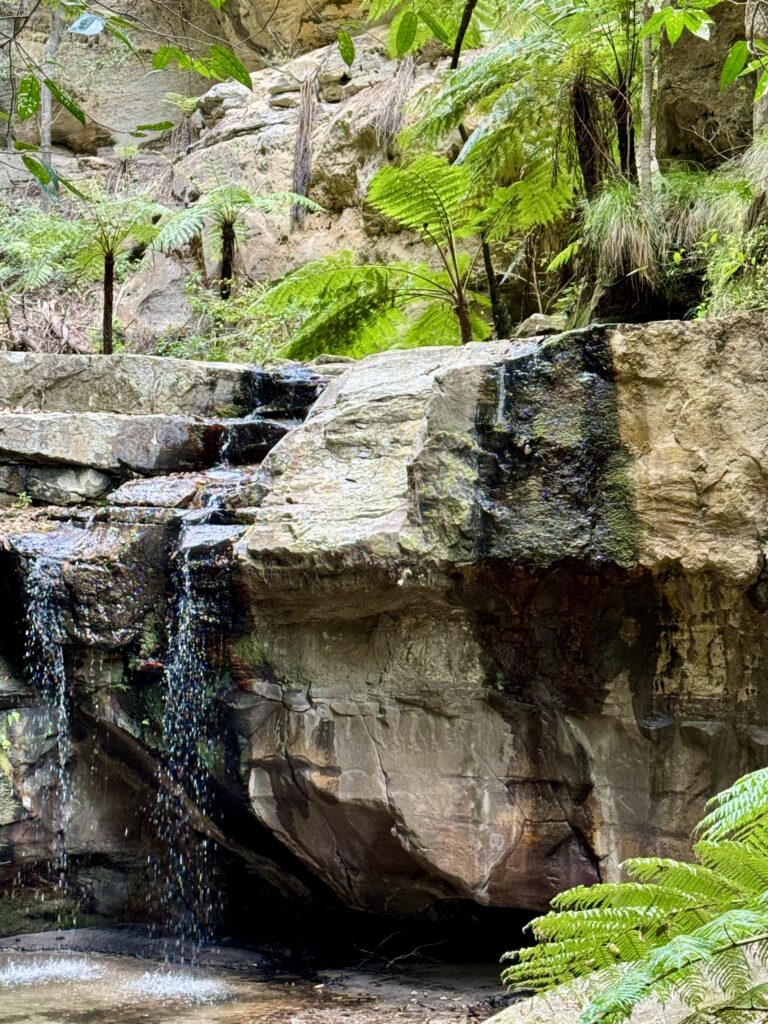



So glad that you’ve tested negative and have joined the group for conversations again. They’ll soon find out what they were missing with you away. I didn’t think your posting yesterday was at all scatty, but I’m sorry that the Covid made you so tired and scatty.
The pictures of the hike in the creek and the moss gardens today (your yesterday) are gorgeous and you must be so happy that you went for the more strenuous option. Your Michelle sounds like an awesome guide and so clever to encourage you to take the path with smaller rocks rather than try to stay dry with the big boulders. The anecdote about quinine bush and the First Nations people is fascinating!
Thanks Carolyn … you are good for my spirit!
You would have enjoyed that walk —- and we are pleased that we’ve not suffered any DOMS (Drlayed Onset Muscle Soreness- the tour leaders term). We thought we might given our reduced physical activity over the last week or so but we’ve decided that climbing into the bus a few times a day for 10 days had probably kept the leg muscles strong. Only a few steps, but steep, and I’ve tried to use my legs more than hauling myself up with the railings!
That First Nations information was really something else. Apparently soldiers who were given quinine as anti-malarial treatment returned home with reduced fertility or infertile. Some never regained their fertility apparently.
I meant to write that I was sorry that Covid made you FEEL scatty—not that you are scatty. 🤣
Got it … haha! Wasn’t offended anyhow!
Hi Sue-Terry,
Excellent news, testing negative. Well done, and it must be wonderful to rejoin the group and partake in conversations. I’m sure you have a great sense of achievement accomplishing the walk to the moss garden, and managing the 600 steps, 3 creek crossing and 5 ridges, particularly being post-Covid. The use of quinine for birth control by the First Nations people was fascinating. I wonder how they initially discovered this? I also love the fact they decided how many children was a workable number for their resources and community to support. It’s a pity our Western cultures doesn’t consider this as well.
Enjoy the rest of your trip now you are free of Covid,
Sue-Percy
Thanks Sue-Percy! It is a relief. Carnarvon gorge was one of the reasons I wanted to do this trip so I made it just! I was worried that COVID might have affected my breathing capacity for such a walk so it was a relief to manage it so easily really after the riot act – but they always do that so we hoped they were this time… haha.
Yes, I’d love to know how they worked this out about quinine – presumably scientific observation over time? Anyhow, as we are learning more and more our first peoples have a lot to teach us, don’t they. It really must be devastating for them to see what is happening to their land. As Melissa Lucashenko suggests in Edenglassie, I think, colonialism was going to happen one way or another but it could have been done differently.
Ohhh…Sue-Terry…..I couldn’t agree more that the first peoples have so much to teach us. It’s a pity we don’t learn from them. It must be devastating for them to see our culture’s disrespect for the land, and the subsequent results. Heartbreaking.
Yes, it is amazing ( and fantastic) that such a recent Covid bout didn’t impact on your breathing capacity.
Happy travels!
Thanks Sue, for this lovely post. How wonderful that you and Len are both Covid free now! I’m sure the other participants are pleased to enjoy your company and conversation again. Good on you and Len for opting for the more challenging walk and for Michelle’s good advice on how to cross the creek/s. Moss Garden is exquisite! Thanks for the photos. Lovely to see the xanthorrhoea in flower! We have one in our courtyard and ‘she’ flowers – almost like a little bride – occasionally… as a cluster of tiny, white stars, each holding a drop of nectar that sparkles in the sun. I hadn’t heard before about quinine other than as a medicine for malaria. There is such great knowledge and wisdom from the traditional culture of our Indigenous peoples. I love that you just ‘drove over the Great Dividing Range’ towards the end of the day… ‘back in the day’ of ‘really olden times’ it would have taken days to make that journey…. and indeed months to cover the path that you are all touring at present. The tin can art piece is clever and attractive! Thanks for sharing it! 😀❤️
Thanks Mary … such a relief to be able to properly be part of the group for the last two nights three days. It’s something! I’m glad all my little stories have interested you … I can fill I more goss when we catch up, but we have had such enthusiastic guides all along the way and our co-passengers have all been great. No one holds the bus up, no one has been pushy. All are interesting.
PS I remember you had an xanthorrhoea … your description of its flowers is beautiful.
Thanks Sue,
Looking forward to catching up with you in person again. I have been medically ‘in empathy’ with you and Len, with a miserable cold (not Covid though) last week and this, and hopefully towards at the end of it now… Look forward also to toasting restored good health with you soon…
Our COVID really felt like a bad cold so we were probably feeling about the same – with just the name being the difference (in practice if not in medical reality)! Len and I are still coughing a bit!
Great post Sue. Good work doing that walk in the time you had! I was trying to remember what walk we did when there 10 years ago or so. I think we walked up to Big Bend and saw the Moss garden on the way back. It’s such a beautiful place.
Fascinating hearing indigenous stories of birth control: very smart community oriented practices.
So good to hear your Covid has abated and you can join in socialising. I’m still Covid+ so haven’t seen the family since we got back yesterday.
Thanks Kate … that was a good walk you did then! It is a beautiful place isn’t it. I am so glad we finally got there.
That birth control story was wonderful. I’m not always keen to do guided walks, but I do know that it can enhance the experience in special ways sometimes.
It took us both about 7 days to test negative. Good luck. It must be frustrating for you having been away for so long and then have this happen but as you return.